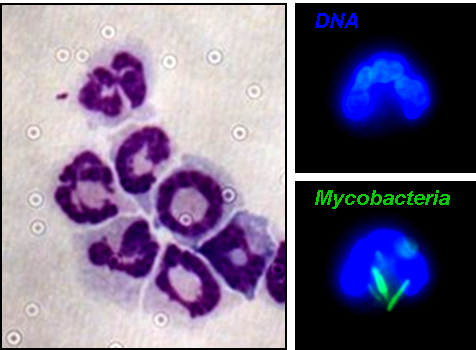BiteSized Immunology: Cells

Neutrophils
Neutrophilic granulocytes or polymorphonuclear neutrophils (PMNs) are the most abundant white blood cell in humans and mice. They are characterised by the multi-lobed shape of their nucleus (Figure 1, left) which distinguished them from other white blood cells of lymphoid or myeloid origin, such as lymphocytes and monocytes.

Right: Human neutrophils harbouring phagocytosed mycobacteria as analysed by fluorescence microscopy.
Neutrophils are the first white blood cells recruited to sites of acute inflammation, in response to chemotactic cues such as CXCL8 (interleukin-8, IL-8) produced by stressed tissue cells and tissue-resident immune cells such as macrophages. Neutrophils therefore comprise a large proportion of the early cellular infiltrate in inflamed tissues and are the major constituent of pus.
Microbial clearance
Neutrophils represent the first line of defence in response to invading microbes, by phagocytosis of pathogens and/or release of antimicrobial factors contained in specialised granules. Phagocytosis is an active, receptor mediated process during which a pathogen is internalised into a specialised vacuole, the phagosome (Figure 1, right).
The interaction with the pathogen can be direct, through recognition of pathogen-associated molecular patterns (PAMPs) by neutrophil pattern recognition receptors (PRRs), or indirect, through recognition of opsonised microbes by Fc receptors or complement receptors. The phagosome undergoes a rapid maturation process that involves the fusion with neutrophil granules and the targeted delivery of antimicrobial molecules and generation of reactive oxygen species (ROS).
Degranulation of specific granules on the neutrophil surface and the extrusion of nucleic acids to form neutrophil extracellular traps (NETs) create an antimicrobial milieu at the inflammatory site and contributes to killing of extracellular pathogens.
Neutrophils at the interface between innate and adaptive immunity
Neutrophils at the interface between innate and adaptive immunity. Neutrophils have historically been viewed as short-lived effector cells of the innate immune system as they undergo spontaneous apoptosis in vitro unless rescued by survival signals such as inflammatory cytokines or microbial compounds (Figure 1, left). However, this view rarely takes into account the notion that neutrophils make important contributions to the recruitment, activation and programming of other immune cells. Recent studies demonstrate that neutrophils themselves secrete an array of pro-inflammatory and immunomodulatory cytokines and chemokines capable of enhancing the recruitment and effector functions of other cells. Neutrophils engage in mutual interactions with a range of immune and non-immune cells, such as dendritic cells (DCs), B cells, NK cells, CD4, CD8 and γδ T cells as well as mesenchymal stem cells, and can be found in draining lymph nodes and the spleen.
© The copyright for this work resides with the BSI
This article was updated in 2022
